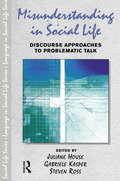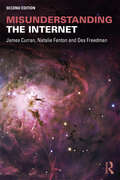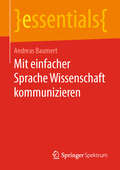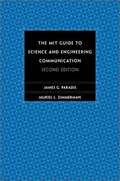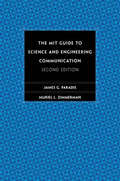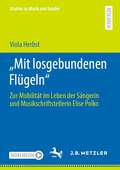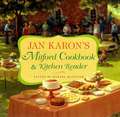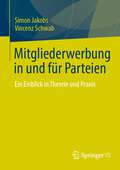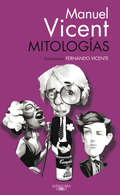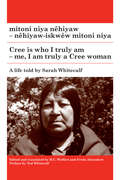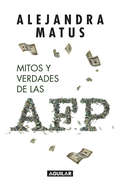- Table View
- List View
Misunderstanding in Social Life: Discourse Approaches to Problematic Talk (Language In Social Life)
by Juliane House Gabriele Kasper Steven RossMisunderstanding is a pervasive phenomenon in social life, sometimes with serious consequences for people's life chances. Misunderstandings are especially hazardous in high-stakes events such as job interviews or in the legal system. In unequal power encounters, unsuccessful communication is regularly attributed to the less powerful participant, especially when those participants are members of an ethnic minority group. But even when communicative events are not prestructured by participants' differential positions in social hierarchies, misunderstandings occur at different levels of interactional and social engagement. Misunderstanding in Social Life examines such problematic talk in ordinary conversation and different institutional settings, including socializing events and story tellings, education and assessment activities, and interviews in TV news broadcasts, employment agencies, legal settings, and language testing. The analyzed interactions are located in a variety of sociocultural environments and conducted in a range of languages, including English, French, German, Hebrew, Japanese, such language varieties as Aboriginal Australian English and Maori New Zealand English, and nonnative varieties. The original studies included in this volume adopt a variety of theoretical perspectives, including discourse-pragmatic approaches, conversation analysis, interactional sociolinguistics, social constructionism, tropological and narrative analysis. They represent multiple views of misunderstanding as a multilayered discourse event.
Misunderstanding the Internet (Communication and Society)
by James Curran Des Freedman Natalie FentonThe growth of the internet has been spectacular. There are now more than 3 billion internet users across the globe, some 40 per cent of the world’s population. The internet’s meteoric rise is a phenomenon of enormous significance for the economic, political and social life of contemporary societies. However, much popular and academic writing about the internet continues to take a celebratory view, assuming that the internet’s potential will be realised in essentially positive and transformative ways. This was especially true in the euphoric moment of the mid-1990s, when many commentators wrote about the internet with awe and wonderment. While this moment may be over, its underlying technocentrism – the belief that technology determines outcomes – lingers on and, with it, a failure to understand the internet in its social, economic and political contexts. Misunderstanding the Internet is a short introduction, encompassing the history, sociology, politics and economics of the internet and its impact on society. This expanded and updated second edition is a polemical, sociologically and historically informed guide to the key claims that have been made about the online world. It aims to challenge both popular myths and existing academic orthodoxies that surround the internet.
Mit einfacher Sprache Wissenschaft kommunizieren (essentials)
by Andreas BaumertSchreiben für den fachfremden, gut ausgebildeten Leser: Worauf muss ein Autor achten? Was geschieht, wenn jemand einen Text versteht, wie kann man ihn dabei unterstützen? Was ist einfache Sprache in Wissenschaft und Technik? Wer eine Vorstellung vom Leser hat, kann auch für diesen schreiben. Mit einfacher Sprache, korrektem und stilistisch hochwertigem Deutsch unterstützt der Schreiber die Prozesse im Gehirn des Lesers. Dieses essential sieht das Arbeitsgedächtnis und seine Anbindung an das Langzeitgedächtnis als entscheidend für das Verstehen. Dessen Aufgaben können Autoren unterstützen und dem Leser so die Lektüre erleichtern. Einfache Sprache fällt dem Leser nur dadurch auf, dass er einen Text gut versteht. Voraussetzung ist immer, dass dieser Text für die Zielgruppe geschrieben ist, der ein Leser angehört.
The MIT Guide to Science and Engineering Communication (Second Edition)
by James G. Paradis Muriel L. ZimmermanThis guide covers the basics of scientific and engineering communication, including defining an audience, working with collaborators, searching the literature, organizing and drafting documents, developing graphics, and documenting sources.
The MIT Guide to Science and Engineering Communication, second edition
by James Paradis Muriel ZimmermanA second edition of a popular guide to scientific and technical communication, updated to reflect recent changes in computer technology.This guide covers the basics of scientific and engineering communication, including defining an audience, working with collaborators, searching the literature, organizing and drafting documents, developing graphics, and documenting sources. The documents covered include memos, letters, proposals, progress reports, other types of reports, journal articles, oral presentations, instructions, and CVs and resumes. Throughout, the authors provide realistic examples from actual documents and situations. The materials, drawn from the authors' experience teaching scientific and technical communication, bridge the gap between the university novice and the seasoned professional. In the five years since the first edition was published, communication practices have been transformed by computer technology. Today, most correspondence is transmitted electronically, proposals are submitted online, reports are distributed to clients through intranets, journal articles are written for electronic transmission, and conference presentations are posted on the Web. Every chapter of the book reflects these changes. The second edition also includes a compact Handbook of Style and Usage that provides guidelines for sentence and paragraph structure, punctuation, and usage and presents many examples of strategies for improved style.
„Mit losgebundenen Flügeln“: Zur Mobilität im Leben der Sängerin und Musikschriftstellerin Elise Polko (Studien zu Musik und Gender)
by Viola HerbstDass heutzutage noch jemand die „Märchenprinzessin“ Elise Polko (1823-1899) kennt, ist vermutlich eher die Ausnahme. In der zweiten Hälfte des 19. Jahrhunderts allerdings war sie durch ihr kulturelles Handeln enorm präsent. Zunächst hatte sie in Leipzig unter Felix Mendelssohn Bartholdy eine Gesangslaufbahn eingeschlagen. Später widmete sie sich als Schriftstellerin bekannten Persönlichkeiten aus der Welt der Musik und erlangte gleich mit ihrem Debüt, den Musikalischen Märchen (1852), ein großes Publikum.Die vorliegende biografische Studie macht Elise Polko wieder sichtbar, wobei sie die Mobilität – verstanden als Bewegung und Beweglichkeit – als kulturwissenschaftliche Perspektive einnimmt. Ihre Gesundheit, Vorbehalte gegenüber schreibenden Frauen, der Beruf ihres Mannes bei der Eisenbahn oder fehlendes Geld mögen Elise Polko eingeschränkt haben, sodass sie nicht immer „mit losgebundenen Flügeln“ unterwegs war. Letztlich entsteht aber das Bild einer bemerkenswerten, eigenständigen und vor allem flexiblen Frau, die allen Umständen zum Trotz am Musikleben des 19. Jahrhunderts partizipierte und dieses mitgestaltete, jedoch in einer werkzentrierten Musikgeschichtsschreibung bislang keine Rolle gespielt hat.
Mitford Cookbook & Kitchen Reader
by Jan KaronThey say that once you learn to ride a bicycle, you never forget how to do it. The same principle, I've discovered, does not apply to cooking. Indeed, I was once a pretty good cook, but my skills have fallen on hard times-and a roast chicken is absolutely the very best I currently can do.
Mitgliederwerbung in und für Parteien: Ein Einblick in Theorie und Praxis
by Simon Jakobs Vincenz SchwabDas Buch fasst wesentliche Erkenntnisse zur Mitgliederwerbung in Parteien systematisch zusammen und gibt darüber hinaus praxisorientierte Tipps, wie sich Mitglieder optimal gewinnen lassen können. Dabei werden partizipationstheoretische, kommunikationspsychologische und nicht zuletzt linguistische Aspekte berücksichtigt. Die Publikation bietet sowohl einen fundierten Einblick in die Mitgliederwerbung von Parteien als auch eine praxistaugliche Handreichung für alle, die neue Mitglieder gewinnen wollen.
Mitologías
by Manuel VicentHéroes, mitos, leyendas literarias... Con gran fuerza expresiva y desde una mirada cáustica, Manuel Vicent demuestra de nuevo su maestría a la hora de realizar retratos literarios. El lector que se aventure en esta galería de retratos, Mitologías de Manuel Vicent, se hallará ante una serie de personajes excepcionales, magnéticos, pero de carne y hueso. En este recorrido alternativo por la historia de la creación literaria y artística, Manuel Vicent pasa del glamour de Andy Warhol a la desdicha de Cézanne o Billie Holliday. Artistas malditos, autodestructivos y abocados a un final trágico como Modigliani o Montgomery Clift contrastan con los que, como Billy Wilder o Sinatra, supieron controlar su destino y alcanzar la felicidad. La honestidad y el compromiso de personajes como Yves Montand o Zenobia Camprubí chocan con la doblez de personajes como el falsificador Van Meegeren o el espía doble Anthony Blunt...
mitoni niya nêhiyaw / Cree is Who I Truly Am: nêhiyaw-iskwêw mitoni niya / Me, I am Truly a Cree Woman (Algonquian Text Society)
by Sarah Whitecalf H. C. Wolfart Freda Ahenakew Ted WhitecalfStrong women dominate these reminiscences: the grandmother taught the girl whose mother refused to let her go to school, and the life-changing events they witnessed range from the ravages of the influenza epidemic of 1918–20 and murder committed in a jealous rage to the abduction of a young woman by underground spirits who on her release grant her healing powers. A highly personal document, these memoirs are altogether exceptional in recounting the thoughts and feelings of a Cree woman as she copes with the challenges of reserve life but also, in a key chapter, with her loneliness while tending a relative’s children in a place far away from home – and, apparently just as debilitating, away from the company of other women. Her experiences and reactions throw fresh light on the lives lived by Plains Cree women on the Canadian prairies over much of the twentieth century. The late Sarah Whitecalf (1919–1991) spoke Cree exclusively, spending most of her life at Nakiwacîhk / Sweetgrass Reserve on the North Saskatchewan River. This is where Leonard Bloomfield was told his Sacred Stories of the Sweet Grass Cree in 1925 and where a decade later David Mandelbaum apprenticed himself to Kâ-miyokîsihkwêw / Fineday, the step-grandfather in whose family Sarah Whitecalf grew up. In presenting a Cree woman’s view of her world, the texts in this volume directly reflect the spoken word: Sarah Whitecalf’s memoirs are here printed in Cree exactly as she recorded them, with a close English translation on the facing page. They constitute an autobiography of great personal authority and rare authenticity.
Mitos y verdades de las AFP
by Alejandra Matus AcuñaUna indagación que destapa los mitos en torno al polémico sistema previsional chileno Alejandra Matus describe de modo ameno, didáctico, claro e irrebatible cómo es, fue y podría llegar a ser el sistema previsional chileno actual. A través de la revisión de documentos y entrevistas a expertos, usuarios y actores del sistema, irá desvelando los secretos del modelo que hoy tiene a los chilenos marchando en las calles. El libro quiere dilucidar múltiples preguntas que inquietan a los chilenos. ¿Por qué y en qué momento se crearon las AFP? Cómo era el antiguo sistema y si es verdad que estaba quebrado. Las transferencias del Estado a las AFP en el momento inicial. La oposición de Pinochet y el por qué los civiles envidiamos a los uniformados. El rol de José Piñera y cómo logró salirse con la suya. Las reformas, como se han fortalecido y las redes de poder que han sostenido el sistema. "Su investigación aborda temas cruciales, desde las críticas más duras hasta las posibles soluciones para mejorar las pensiones de los chilenos."
Mittens
by Barbara W. MakarA systematic, phonics-based early reading program that includes: the most practice for every skill, decodable readers for every skill, and reinforcement materials--help struggling students succeed in the regular classroom
miVisión Lectura 1 [Unidad 1], Libro interactivo del estudiante
by María G. Arreguín-Anderson Richard GómezNIMAC-sourced textbook
miVisión Lectura, 1 [Unidad 3] Libro interactivo del estudiante
by María G. Arreguín-Anderson Richard GómezNIMAC-sourced textbook
miVisión Lectura, 1 [Unidad 4], Libro interactivo del estudiante
by María G. Arreguín-Anderson Richard GómezNIMAC-sourced textbook
miVisión Lectura 1 [Unidad 5], Libro interactivo del estudiante
by María G. Arreguín-Anderson Richard GómezNIMAC-sourced textbook
miVisión Lectura, 2 [Unidades 1 y 2] Libro interactivo del estudiante
by María G. Arreguín-Anderson Richard GómezNIMAC-sourced textbook
miVisión Lectura, 2 [Unidades 3 a 5] Libro interactivo del estudiante
by María G. Arreguín-Anderson Richard GómezNIMAC-sourced textbook
miVisión Lectura, 3 [Unidades 1 y 2] Libro interactivo del estudiante
by María G. Arreguín-Anderson Richard GómezNIMAC-sourced textbook
miVisión Lectura, 3 [Unidades 3 a 5] Libro interactivo del estudiante
by María G. Arreguín-Anderson Richard GómezNIMAC-sourced textbook
miVisión Lectura 4 [Unidades 1 y 2], Libro interactivo del estudiante
by María G. Arreguín-Anderson Richard GómezNIMAC-sourced textbook
miVisión Lectura 4 [Unidades 3 a 5], Libro interactivo del estudiante
by María G. Arreguín-Anderson Richard GómezNIMAC-sourced textbook
miVisión Lectura, 5 [Unidades 1 y 2] Libro interactivo del estudiante
by María G. Arreguín-Anderson Richard GómezNIMAC-sourced textbook
miVisión Lectura, 5 [Unidades 3 a 5] Libro interactivo del estudiante
by María G. Arreguín-Anderson Richard GómezNIMAC-sourced textbook
miVisión Lectura K [Unidad 1], Libro interactivo del estudiante
by María G. Arreguín-Anderson Richard GómezNIMAC-sourced textbook
